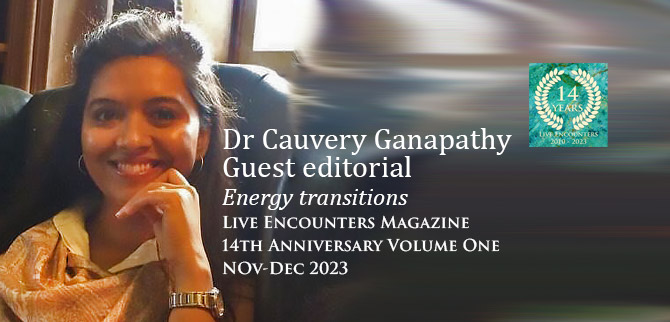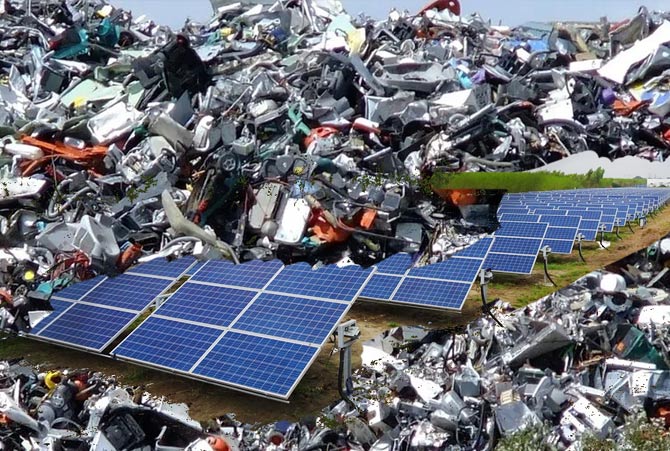
Download PDF Here
14th Anniversary Edition, Live Encounters Magazine, Volume One Nov-Dec 2023.
Energy transitions, Reneging on ambitions, Guest editorial by Dr. Cauvery Ganapathy.

The most compelling answer to addressing the fallouts of climate change, and inhibiting, if not marginally stalling, the negative impacts of global warming is, quite expectedly, a transition to cleaner forms of energy. The low-carbon pathways that are being charted to this end, use remarkable technological innovation to bring about this transformation in the field of energy usage. There are, however, many loftier presumptions that have been attributed to the anticipated deliverables from this clean energy transition. Prominent among these is the expectation that these largely decentralized systems of energy, will necessarily translate into a diffusion of egalitarian distributive systems alongside greater demo-cratization of energy access, and eventually rectify the past injustices and inequities of the traditional energy system. This commentary is based upon the premise that there is a blind-spot in this mammoth expectation that is commonly levied upon the new energy systems.
In many ways, the deliverables set up for these new forms of energy, far supersede their ability as well as their mandate. The clean energy transition, by being bestowed with the expectation of deliveringambitious deliverables such as energy justice and greater democratization of energy, is quite unfairly being asked to fix fractured local and global politics, something considerably more complicated than the energy systems are equipped to handle. Although their very purpose and objective is to revolutionize the ways of global energy generation and usage, these low-carbon systems, and the efforts to expand their base operate within socio-political ecosystems that have hardly mutated at the pace the technologies emerging from it have. As a result, the persistence of divisions continues to be the norm within this new energy system too.
There are two significant divisions that may broadly be drawn in the story of the new energy system transition presently. The first is based on the issue of resource distribution. The rare earth elements that are the essential raw materials that power the clean energy systems, have a spatial distribution that is even more skewed in favour of a tiny group of countries than was the case with the fossil fuels. The Democratic Republic of Congo, for instance, has 49% of the world’s confirmed cobalt reserves- nearly all of which again, is concentrated in a single region of the DRC itself, Katanga.
Simultaneously, according to the IEA, the concentration of the processing capacity of these raw materials is even more pronounced with China alone accounting for nearly 90% of the world’s rare earths, 50-70% of lithium and cobalt, and nearly 35% of the world’s nickel refining. The second division, part of both, the upstream as well as downstream of this global supply chain, is that the countries of the Global South which, at the moment, use a tiny fraction of the final products generated through these new technologies, find themselves being central to the whole enterprise with the extraction of their natural resources while also being the largest recipients of the toxic e-waste that is generated from these products.
It would be worthwhile to consider if as a result of these two divisions the clean energy systems find themselves straddling the mandates of energy justice, energy inefficiencies, energy access, climate injustice, energy poverty, energy and resource inequities, while repeating the errors of the old system that it was engineered to replace, in the first place.
IRENA’s projections suggest that a meaningful shift to low carbon pathways would mean the deployment of close to a billion passenger electric vehicles by 2050. Accompanying that number is the agency’s projection for a significant jump in the storage capacity to be close to 12,380GWh by the same time. Both of these numbers have substantive implications for the kind of mineral and rare earth elements extraction and processing that would be needed- highest among them being the spike in demand for cobalt, copper, lithium and nickel.[1] The finite nature of the resources that undergird the clean energy transition, whether the raw materials for the photovoltaic cells or the lithium batteries, lie at the heart of the problems that allow for the faults of the old system to seep into these new energy forms.
The economic motivations for the rampant and urgent exploitation of scarce commodities that fuel this inspired low-carbon answer to the travails of climate change, vitiate the potential of the new energy systems to break the intergenerational inequities that abounded in the old energy systems. Unfortunately, the upstream processes such as mining and extraction that are involved in the sourcing of these essential elements for the fueling of this clean energy revolution is beget with a rate of human and environmental exploitation that is at par, if not greater, than the transgressions in the domain made in the traditional energy systems.
The Global South has been the overwhelming recipient of the e-waste that has been generated through the downstream process of the supply chain. Despite the upward trajectory in the production of EVs, that use the lithium batteries, for instance, technology has not yet been fine-tuned to address the question of efficiently and safely recycling the gigantic amounts of depleted batteries that are to be produced as part of the EV revolution in the automotive sector. At the downstream end of the supply chain, the e-waste that is generated by the depleted batteries as well as the solar panels [2] that are central to the low-carbon transitions, as well as the waste generated by the wind turbines, have been actively destroying environmental protection mandates in the Global South. This, then, would result in an increased exposure of e-waste to the water bodies and landfills of the Global South.
Environmental pollution has been proven to be a part of the extraction process for cobalt, for instance, and yet it remains on the fringe of the clean energy transition discussions. A clean energy transition that is just and addresses the inequities of the old systems is importantly a temporal issue, which means that to not regulate globally immediately on the issues of extraction, usage and disposal of waste would endanger the possibility of a sustainable energy transition. Externalities such as the environmental risk and pollution that are ancillary to the extraction and processing of cobalt, throughout its life-cycle and the entire supply chain that makes use of it, for instance, should be an important factor of consideration when the final costs of the clean energy options are computed.
The fact that many of the fundamental elements that the new forms of energy are dependent on are rare resources that need to be mined introduces into the transition the element of exploitation in the labour force. The very conduct of the extraction process in countries of Africa where the use of child-labour and abysmal working conditions has been shown to exist, feed into the structural inequities that existed in the traditional resource exploitations of the old system. To not, then, demand a clean and transparent supply chain, would feed into the older narrative and perpetuate and aggravate the flaws of the older system.
Existing cleavages are exacerbated when underlined by a profit motivation, just as ethnic tensions and community fractures are known to expand far more rapidly in the case of resource extraction. Unfortunately, the lucrative nature of mining for these elements, despite their environmental and health costs, has meant that it has become an avenue- oftentimes, the only one- for marginalized populations to escape the scourge of poverty and hunger. It is an arrangement that works for both sides- all of us who need that cobalt for fulfilling our earnest commitment to the clean energy transition, and them, who need for that cobalt to be in constant demand, so that they can monetize their land and labour to escape their vicious reality of impecuniousness.
While there are these undercurrents of persisting tensions inherent in the supply chains and the very generation of these low carbon forms of energy, there are also examples where the deployment of the cleaner forms of energy through new technologies have in fact, fulfilled some of the grand ambitions that have been made synonymous to them through policy pronouncements.
These systems have, in places, challenged and dramatically altered the long-drawn monopolies of the energy behemoths. The deployment of solar panels on residential rooftops, for instance, has been responsible for creating substantive leaps in the process of not just energy access but triggered a fantastic devolution of authority in the field of energy systems.
The creation of micro-grids where excess energy generated off solar panels in houses can be sold within the local community, through the use of blockchain technology in some places, for instance, is an example of how greater agency has been accorded to people in the adaptation and spread of cleaner forms of energy. The use of these formats also enables considerable controls over the loss of excess energy and partly addresses the issue of energy storage. Initiatives/projects such as this, enable a decentralization of the energy systems that would be impossible if left to the more traditional energy pathways.
Good prudent policy imperatives also carry unintended consequences. This is something that the efforts to enable low-carbon energy transitions has also had to contend with. The diffusion of new technologies, naturally, has a much steeper learning curve than the continued proliferation of the older forms of energy. These new cleaner forms of energy are order of magnitudes more preferable to the older forms, by virtue of their impact on the environment, and on a possible devolution of energy authority leading to lessened monopolies. Delving into any possible lacunae within either their deployment or ramifications, should not, therefore, be understood as being an exercise in undermining their value. It is instead an effort to identify the features that may plague these energy systems in the future, in a manner that would nullify the massive benefits that would most naturally flow from it.
The propagation of these cleaner forms of energy borne of new technologies, not only makes abundant sense but is, in fact, the only prudent trajectory to pursue to mitigate the impacts of Climate change. Yet, given that the new energy transition is the only alternative that the world has available, the margin for error is that much more meagre. It is this very imperative of getting it right that makes it necessary to appreciate that these new low carbon energy systems, harbour within their global supply chain, some of the negatives of the old forms of energy. It would serve our clean energy ambitions better to urgently consider the possibility that overlooking these remnants of the old form would negate any efforts for the end result of this promising transition to be sustainable.
1. E. Dominish, N. Florin, S. Teske
Responsible minerals sourcing for renewable energy, Report prepared for earthworks by the institute for sustainable futures, University of Sydney (2019)
2. Solar panels are ahead in terms of pure numbers and scale than the lithium batteries, presently, where their proportionate contribution to the e-waste segment is concerned
© Dr. Cauvery Ganapathy
Dr. Cauvery Ganapathy is a strategic affairs analyst, and works as a Strategic Risk Management Consultant. She has been a Research Associate with the Office of Net Assessment under the US Department of Defense previously. As a Fellow of Global India Foundation, she has presented and published at various national and international forums. She has been a recipient of the Pavate Fellowship to the University of Cambridge as Visiting Research Faculty and a recipient of the Fulbright-Nehru Doctoral Fellowship to the University of California, Berkeley.


A cogent and carefully nuanced line of argument. Thank you.
Very well researched essay presenting the useful analysis in simple words for everyone to understand. I hope the policymakers are listening.